Kerala Plus Two Economics Previous Year Question Paper March 2017 with Answers
| Board | SCERT |
| Class | Plus Two |
| Subject | Economics |
| Category | Plus Two Previous Year Question Papers |
Time: 2½ Hours
Cool off time : 15 Minutes
General Instructions to candidates
- There is a ‘cool off time’ of 15 minutes in addition to the writing time of 2½ hrs.
- Your are not allowed to write your answers nor to discuss anything with others during the ‘cool off time’.
- Use the ‘cool off time’ to get familiar with the questions and to plan your answers.
- Read questions carefully before you answering.
- All questions are compulsory and only internal choice is allowed.
- When you select a question, all the sub-questions must be answered from the same question itself.
- Calculations, figures and graphs should be shown in the answer sheet itself.
- Malayalam version of the questions is also provided.
- Give equations wherever necessary.
- Electronic devices except non-programmable calculators are not allowed in the Examination Hall.
Question 1.
Which one of the following condition is not satisfied by the long-run equilibrium of a firm under perfect condition?
a) P = AR
b) AR = MR
c) MC = MR
d) AFC = AVC
Question 2.
Identity the curve given below. What does points A, B, C represents?
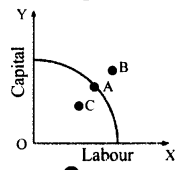
Question 3.
Match the following:
M1 : Most commonly used measure of money supply
M2: Least liquid form of money supply
M3: M1 + Post Office Savings Deposits
M4: CU + DD
Question 4.
Fill in the blanks:
I.___= Revenue Expenditure – Revenue Receipts.
II. Primary Deficit = _____ – Net Interest Liabilities.
Question 5.
Suppose the demand and supply functions of wheat are given by QD = 800 – 4P and QS = 600 + 4P respectively.
I. Find the equilibrium price and quantity demanded.
II. Due to a shortage of fertilizers, the cost of production of wheat is increased. So that the new supply function is QS = 400+4P. What will happen to the equilibrium price and quantity demanded?
Question 6.
Explain the working of a pegged exchange rate system with suitable diagram.
Question 7.
Why there is different price elasticity along a linear demanded curve? Illustrate with the help of a diagram.
Question 8.
Write a note on the interest responsiveness of the following motives for the demand for money.
I. Transaction Motive
II. Precautionary Motives
III. Speculative Motives
Question 9.
From the Budget line shown below, find the price of good X2 given that the price of X1 good is Rs.30. The equation on the Budget line is given as P1X1+P2X2 = 1000.

(Hint: X and Y axes shows the number of units of respective goods purchased)
Question 10.
Which of the following is not correct?
I. Y = C + I + G + X – M
II. GNP = GDP + Net Factor Income from abroad
III. NNP = GNP – Depreciation
IV. NDP = GDP – Net Indirect Taxes
Question 11.
Goods which are consumed together is known as
a. Substitute goods
b. Complementary goods
c. Normal goods
d. Giffen goods
Question 12.
Elucidate the working of Autonomous Expenditure Multiplier Mechanism with a suitable example. Show the impact of a decline in MPC on multiplier.
Question 13.
Match the following:
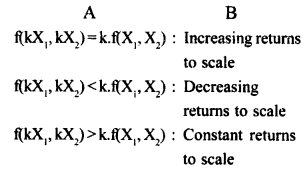
Question 14.
Which among the following is not a characteristic of a Capitalist Economy?
a. Wages and prices are administered by the government.
b. Private ownership of means of production.
c. Production takes place for exchange.
d. Sale and purchase of labor services at a price is called wage rate.
Question 15.
Rising portion of long run marginal cost curve from the minimum of long run average cost curve is known as
a. Long run supply curve of the firm.
b. Long run demanded curve of the firm.
c. Variable cost curve of the firm.
d. Fixed cost curve of the firm.
Question 16.
Graphically explain the short run equilibrium of the firm under Perfect Com-petition. Draw separate diagram depicting the following conditions:
I. The firm is earning super normal profit.
II. The firm is earning only normal profit.
III. The firm is incurring a loss.
Question 17.
How does equilibrium price and quantity demand affected when
I. Both demand and supply curves shifts in the same directions.
II. Demand and supply curve shifts in the opposite directions.
Question 18.
Why the Average Revenue Curve and Marginal Revenue Curve of a firm under monopolistic competition is negatively sloped?
Question 19.
Examine the diagram given below. Identify the mistake and redraw the diagram. What is the relation between Total Revenue and Marginal Revenue as the firm expands its output?
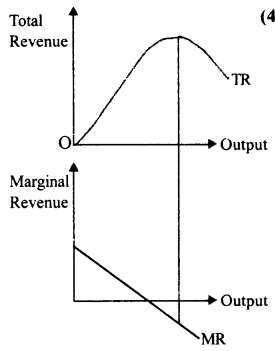
Question 20.
Distinguish between a stock and flow variable. Illustrate with examples.
Question 21.
Explain the concept of High powered money.
Question 22.
Consider the following diagram. Answer the following questions:
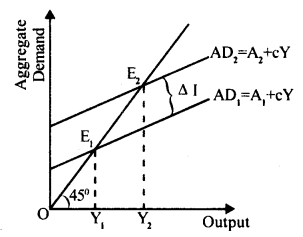
I. What does the 45° line represent?
II. What is the difference between A1 and A2?
III. List two possible reasons for an increase in Autonomous Expenditure.
IV. When the economy moved from E1 to E2, the Aggregate output is increased more as compared to Aggregate Expenditure. Why?
V. Explain the movement of the economy from E1 to E2.
Question 23.
Among the following choose the one which represents the multiplier

I. What does the 45° line represent?
II. What is the difference between A1 and A2?
III. List two possible reasons for an increase in Autonomous Expenditure.
IV. When the economy moved from E1 to E2, the Aggregate output is increased more as compared to Aggregate Expenditure. Why?
V. Explain the movement of the economy from E1 to E2.
Question 24.
Distinguish between Revenue Expenditure and Capital Expenditure
Question 25.
Differentiate between Devaluation and Depreciation.
Question 26.
The following table shows the total cost schedule of a firm. Calculate TVC, AFC, AVC, SAC and SMC schedules.
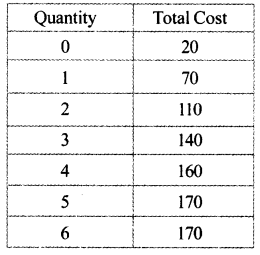
(Hints: TVC = Total Variable Cost, AFC = Average Fixed Cost, AVC = Average Variable Cost, SAC= Short run Average Cost, SMC= Short run Marginal Cost.)
